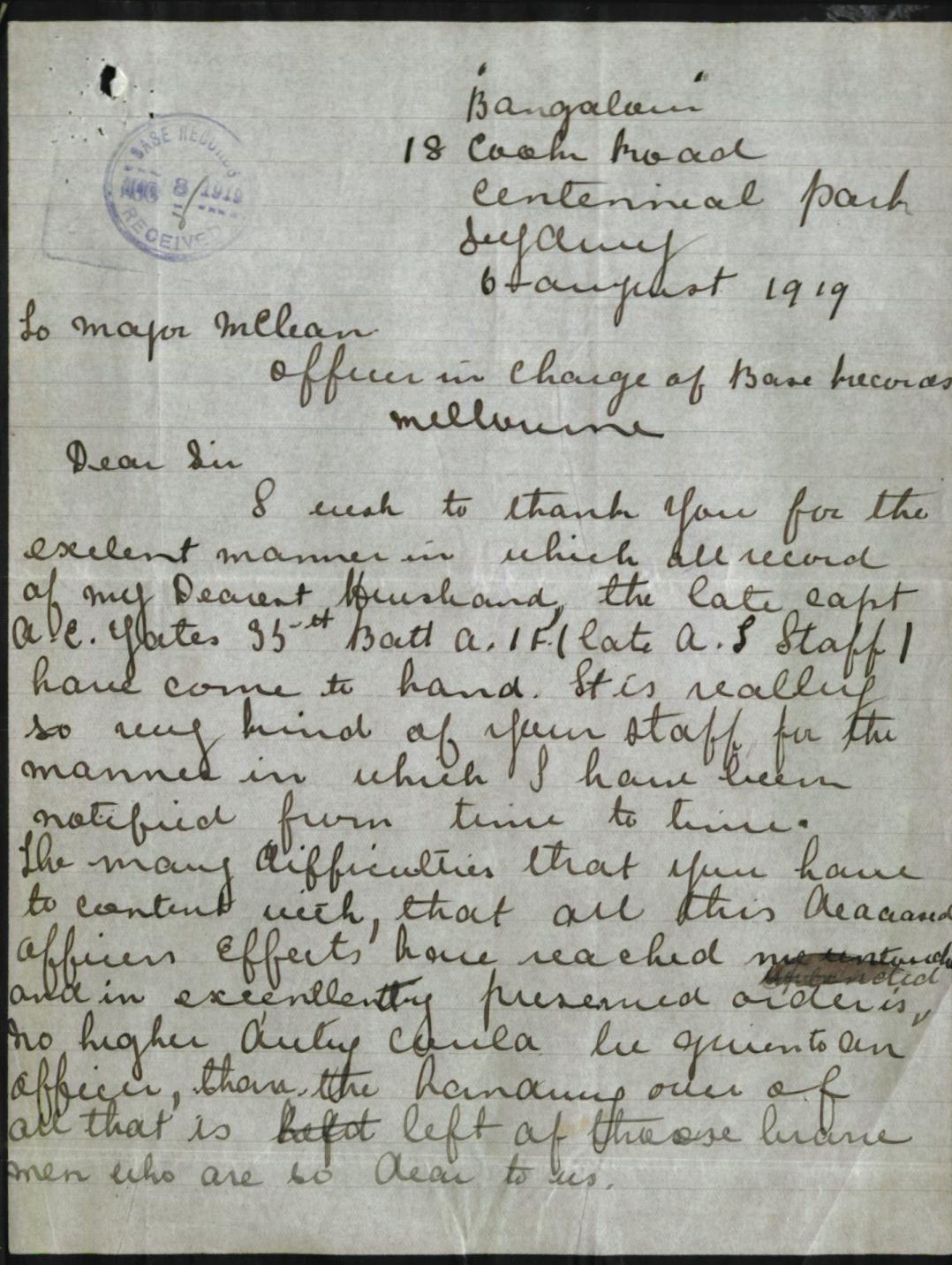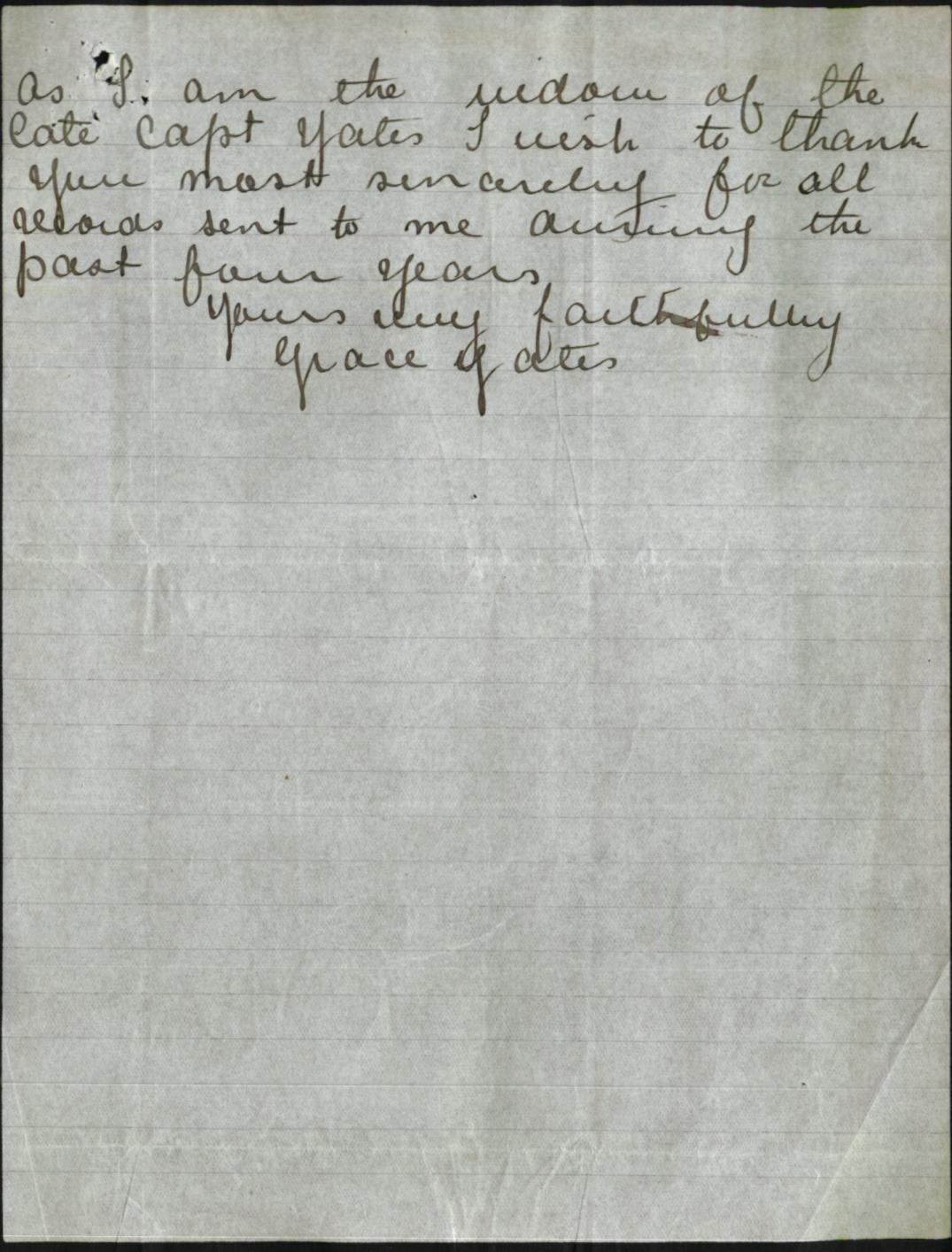Family historians, can you help us? We’d love to know more about Grace Yates and source an image of her. Please get in touch if you can help.
Grace Yates
War widow, businesswoman
Following the death of her husband, Captain Albert Yates, MID, in action with the AIF on the Western Front in 1918, English-born war widow Grace Yates began running a boarding house in Sydney. Her business was subsidised by the Repatriation Department and enabled her to supplement her war widow’s pension and the allowances for her young children. She continued taking paying guests until 1923. Her subsequent movements are unknown, it is possible she returned to England.
Grace Yates was widowed on 8 August 1918 when her husband English-born Captain Albert Edward Yates AIF was killed in action at Battle of Hamel while leading his company. He was 33. His remains were interred near Hamel and reinterred at Villers-Bretonneux Military Cemetery. Albert Edward Yates (also known as George), born on 1 May 1886 at St Helens, Lancashire, England, was a professional soldier who spent five years with the Instructional Staff, North Lancashire Regiment, before arriving in Australia in 1910 with Grace and their two young children. He spent the following six years on the Instructional Staff at the Royal Military College, Duntroon, as Squadron Sergeant Major. A freemason, a keen cricketer and middle-distance athlete, he conducted weekly rifle drills for civilians while stationed at Duntroon.
Yates enlisted in the AIF on 23 February 1916 and was immediately commissioned as a lieutenant and posted to the 35th Battalion. When he left Australia in May 1916, Grace and their children were living in Sydney. Yates served in France from November 1916 with the Machine Gun Section of the 35th Battalion and was promoted to captain in December 1916. He was Mentioned in Despatches in General Douglas Haig’s despatch of 9 April 1917 and was killed in the Battle of Hamel on 8 August 1918, aged 33.
During the years after his death, Grace, like other war widows, appears in her husband’s Army file when she signed for consignments of his possessions ranging from the items found on his body to his officer’s cabin trunk and later when she accepted his Victory Medal, Memorial Plaque, Memorial Scroll and King’s Message. Grace also signed for his commission severing his appointment as a temporary lieutenant in the British Army regular forces, allowing him to enlist in the AIF. During this time Grace moved from Sydney addresses in Paddington and Kogarah before settling for about four years at Centennial Park and in 1923 in Waverley.
Grace was very appreciative of the Army’s efforts in locating and sending her husband’s possessions even a cabin trunk, which was apparently missing for some time, and which contained his masonic apron which she wished to pass on to her young son. She wrote to the Officer in Charge of Base Records in Melbourne on 6 August 1919:
The many difficulties that you have to contend with that all the deceased officer’s effects have reached me and in excellent preserved order is appreciated. No higher duty could be given to an officer, than the handing over of all that is left of these brave men who are dear to us.
On 28 February 1923, when ‘a dear friend and close relative’, W. Atwell of Auckland, New Zealand, indicated he was going to visit the battlefield grave of the late Captain Yates, the Army gave Grace detailed instructions on locating the grave to pass on to her relative.


Letter from Grace Yates thanking the Army for sending records of her late husband, Captain A E Yates. NAA: B2455 YATES A E
Grace Yates was granted a war widow’s pension of £3-17-6 per fortnight with £1-15-0 for the two children making a total of £5-12-6 per fortnight. The Yates Repatriation file discloses that she planned to supplement this income by starting a business providing residential accommodation for paying guests. She started her residential in a house at Cook Road, Centennial Park, for which the rent was £2 per week. On 11 December 1919 she applied under the Repatriation Act for a loan of £35 to purchase furniture for improvement of her residential in Centennial Park. The Department approved payment for an oak 3-piece bedroom suite and wardrobe, an oak sideboard, dining table and two dining chairs. It appears the Department also provided other financial help which owing to its substantial amount may have been to set her up in a suitable house. An undated, unexplained document, which is the last item to appear in the Yates file and which was signed by Grace Yates, states that a sum of £13,000 was paid for assets to be taken over, implying the end of the business. Grace’s last address recorded by the Army was ‘Lester’, Botany Street, Waverley, in 1923.
The movements of Grace Yates and her children after 1923 are not disclosed in Army or Repatriation records and nothing further has been discovered in other sources. It is possible that she returned to England to live. During the first few years after the shock of the loss of her husband she had shown great enterprise in attempting to earn an income.
DR PATRICIA CLARKE OAM FAHA
Archival resources
- NAA B2455 First AIF Personnel Dossiers 1914-1920, Yates, Albert Edward Captain, barcode 3453904.
- NAA C138, Personal case files, single number series (Australian, 1914-1918 War), Yates, George (aka Albert Edward), R54888, barcode 22362444.
Published sources
- Commonwealth Gazette No. 169, 4 October 1917 (MID)
Online sources
- ACT Memorial, YATES, Albert Edward, www.memorial.act.gov.au/search/person/yates-albert-edward
- AIF Project UNSW, Albert Edward Yates, www.aif.adfa.edu.au/showPerson?pid=334016